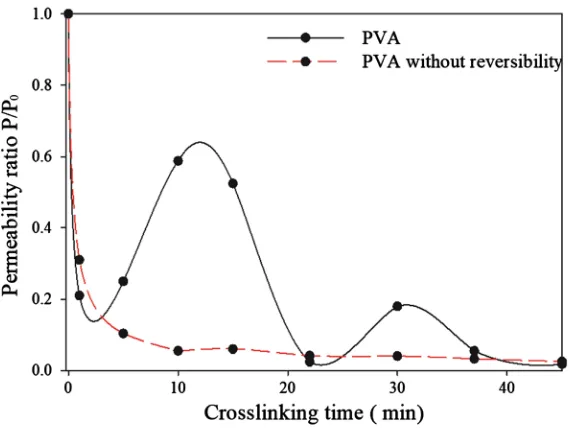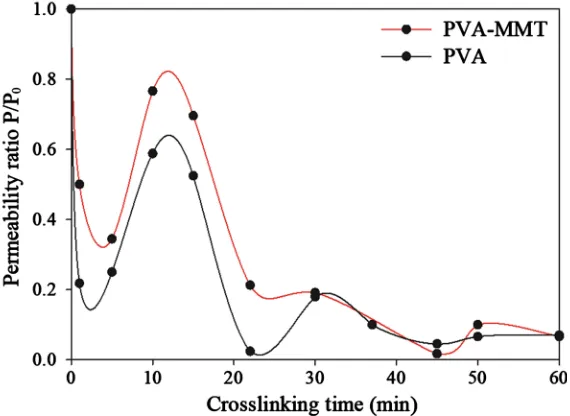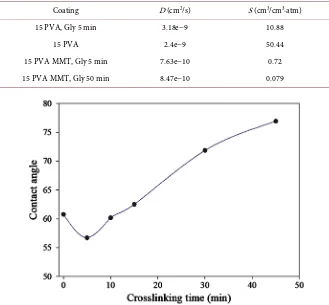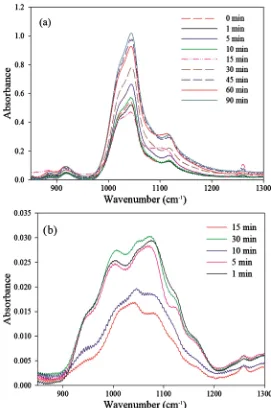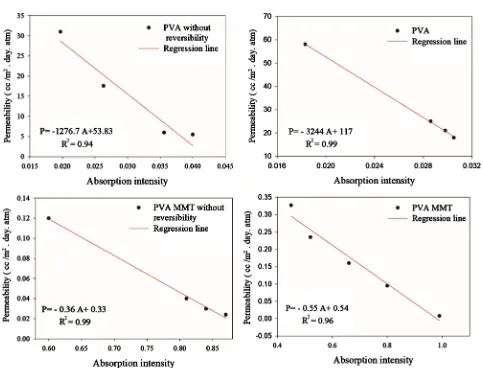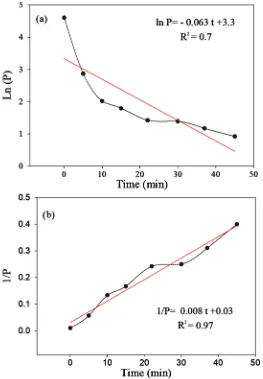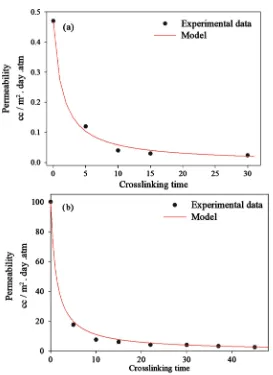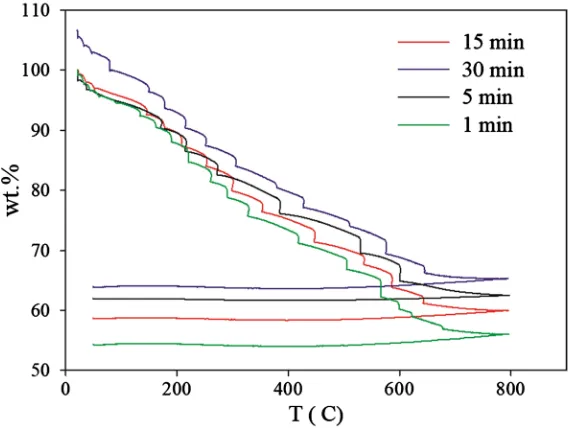ISSN Online: 2165-6711 ISSN Print: 2165-6681
DOI: 10.4236/ojpchem.2019.94009 Nov. 1, 2019 100 Open Journal of Polymer Chemistry
Study of the Crosslinking of PVA
with Glyoxal in LbL Nanocomposites
Fatma Ben Dhieb
1, Adrián Carrillo García
2, Seyed H. Tabatabaei
3, Frej Mighri
4, Abdellah Ajji
1*1Chemical Engineering Department, Polytechnique Montreal, CREPEC, Montreal, Canada
2Chemical Engineering Department, Polytechnique Montreal, Montreal, Canada 3ProAmpac, Terrebonne, Canada
4Chemical Engineering Department, Laval University, CREPEC, Quebec City, Canada
Abstract
Crosslinking is a common practice to improve the barrier properties of poly-mers. In this study, Montmorillonite (MMT) was used with Polyvinyl alcohol (PVA) to deposit nanocomposite coatings which were crosslinked with gly-oxal (Gly) by Layer by Layer (LbL) on a PET substrate. Two crosslinking conditions were studied, under mild condition and with an acidic environ-ment. Mild condition was useful to identify the reversibility steps and the op-timum crosslinking times while the acidic environment was essential to in-vestigate the crosslinking mechanism, by determining the permeability for different crosslinking times. PVA and PVA-MMT coatings showed a strong correlation between the permeability coefficients for different crosslinking times and the FTIR results.
Keywords
Glyoxal, LbL, Nanocomposite, PVA, Crosslinking Mechanism
1. Introduction
Barrier materials are in constant demand for a wide variety of applications, es-pecially for food packaging which has a considerable growth of the flexible pack-aging market. Polymeric materials are a considerable part of this market and many technologies are currently applied to improve their gas barrier. The most popular, is the multilayer structured film in which a barrier layer (ethylene vinyl alcohol (EVOH), Nylon…) is usually part of a three to twelve layers structure. Metallic and silicon oxide coatings are also extensively used for high barrier packaging. In addition to these two, other techniques are also used to improve the cost and
How to cite this paper: Dhieb, F.B., García, A.C., Tabatabaei, S.H., Mighri, F. and Ajji, A. (2019) Study of the Crosslink-ing of PVA with Glyoxal in LbL Nano-composites. Open Journal of Polymer Che-mistry, 9, 100-116.
https://doi.org/10.4236/ojpchem.2019.94009 Received: July 22, 2019
Accepted: October 29, 2019 Published: November 1, 2019 Copyright © 2019 by author(s) and Scientific Research Publishing Inc. This work is licensed under the Creative Commons Attribution International License (CC BY 4.0).
http://creativecommons.org/licenses/by/4.0/
DOI: 10.4236/ojpchem.2019.94009 101 Open Journal of Polymer Chemistry the recyclability like polymer blending, and the addition of fillers.
Nanocomposite coatings are considered a sustainable solution, due to their recyclability and the increasing interest in ecofriendly materials like clay [1], cellulose nanocrystals [2] or chitosan [3].
For nanocomposites, some affordable materials like clay, improves considera-bly the polymer properties even with adding low amounts, due to its high aspect ratio [4]. The dispersion and exfoliation of clay depend mainly on its interaction with the polymer and the applied process. Especially for melting and casting, high clay loading can’t be reached due to its agglomeration that may deteriorate the barrier properties [5]. Coating, in the other hand, resulted in a better clay dispersion and intercalation [6].
Among the coating techniques, Layer by Layer (LbL) was developed in the early 90’s and consists in the alternate deposition of polymer layers [7]. The filler can be added whether directly to the polymer solution that will be deposited, or it can be deposited as a separate layer by dipping (for dip coating) the substrate in the filler solution. LbL has shown interesting results compared to conven-tional techniques by reducing oxygen permeability by up to 99.9% [8]. Obtained coatings have a tailored thickness that depends on the number of layers, the properties of the used materials (fillers and polymers) and the coating steps. To increase gas barrier and reduce the sensitivity to moisture, these coatings are usually chemically crosslinked [9]. For polymers with hydroxyl and amine func-tional groups, dialdehydes in particular are widely used. Their remarkable reac-tivity results in a high crosslinking density, reducing thus considerably the free volume in the film. Other than the gas barrier, crosslinking improves also the mechanical properties [10] due to the modification of the polymer structure with the established covalent bonds [11]. The acetal formation and crosslinking reac-tion is known to be reversible, which could be avoided with acidic condireac-tions. Some studies conducted this reaction under mild conditions and resulted in a non proportionality between the crosslinker concentration and the density of crosslinking [12]. Most of the crosslinking studies consider a homogeneous sys-tem in which the crosslinker solution is added to the polymer solution [11] [13]
while heterogeneous reaction is not extensively studied.
To the best of our knowledge, this is the first thorough study of the variation of permeability with crosslinking time, the tracking of the acetal reaction re-versibility and the correlation of permeability and FTIR absorption intensity for LbL coatings.
DOI: 10.4236/ojpchem.2019.94009 102 Open Journal of Polymer Chemistry contact angle measurement.
2. Experimental
2.1. Materials
PVA (Mw = 140,000 - 186,000 g∙mol−1) was purchased from Sigma Aldrich
(Saint Louis, Missouri, USA) and Natural sodium montmorillonite (MMT) (Cloisite NA+) with a density of 2.86 g/cm3, supplied by BYK (Gonzales, Texas,
United States), was used as received. Silicon wafers, purchased from EL-Cat Inc. (Ridgefield Park, New Jersey, United States) were also used as substrate. They were used for the FTIR characterization due to their transparency to infra-red. The selected substrate for permeability tests and the other characterizations, is a polyethylene terephthalate (PET) film, 16 μm, provided by ProAmpac (Terre-bonne, QC, Canada). The used primer is a polyethylene imine solution (PEI) (5% aqueous solution), purchased from MICA Corporation (Shelton, CT, USA). Glyoxal, the crosslinker, (40% aqueous solution) and Hydrochloric acid (37%) were purchased from Sigma Aldrich (Saint Louis, Missouri, USA).
2.2. Dip Coating Preparation
PVA solution was prepared with deionized (DI) water with continuous stirring for 2 h and heating at 80˚C. MMT suspension in DI was stirred for at least 4 hours. Deposition of a coating by LbL is a repetition of three steps to deposit each layer: dipping of the substrate in the PVA or MMT solution, rinsing and drying. For the first bilayer (the first layers of PVA and MMT) the time for each step is higher to have a better coverage. Crosslinking the LbL coatings consists in dipping the coated substrate in the glyoxal solution (5%), twice: after the deposi-tion of half the layers and at the end when all the bilayers are deposited. For crosslinking reaction with the presence of acid, hydrochloric acid (0.1 M) is added to the crosslinker solution.
2.3. Determination of the Solubility and Diffusion Coefficients
To determine the solubility and diffusion coefficients of the coated substrate, the unsteady state is required. To achieve it, the tested films are first conditioned in the MOCON apparatus with nitrogen only for several hours, and then tested with nitrogen in order to remove all the oxygen trapped in the film. A test of the oxygen permeability is started directly afterwards without conditioning. With this unsteady state, Fick’s second law can be applied, Equation (1). Diffusion and permeability coefficients are determined with the solution to this law, Equation (2), and the solubility is calculated with Equation (3).2 2 C C D t x ∂ = ∂
∂ ∂
(1)
( )
1 2 1( )
1 exp 22 2n
n
Pp D n t
J t
l l
∞ =
π
= + − −
DOI: 10.4236/ojpchem.2019.94009 103 Open Journal of Polymer Chemistry
P= ⋅S D (3)
3. Characterization Techniques
The interlayer spacing d (001) of MMT was determined according to Bragg’s law, by using X-ray diffraction spectroscopy (Philips X’pert) in the wide-angle mode and copper CuKα radiation (λ =1.54056 Å) as a source. The coatings were scanned with a rate of 0.02˚/s in the range of 2 to 10 degrees. MOCON OXTRAN 2/21 (Minneapolis, USA) apparatus was used to measure the permea-bility to oxygen at 0% relative humidity, 25˚C, and 1 atm pressure, as described in the ASTM standard, D-3985-81. For a higher relative humidity (70%), tests were conducted with a MOCON OXTRAN 10X apparatus (Minneapolis, USA), at 25˚C.
The contact angle of the coated PET was determined with the sessile drop method by using a Goniometer OCA20 from dataphysics. Measures were done at room temperature and distilled water was the probe liquid. To determine the contact angle, the drop image to analyze is considered the one taken after 5 sec-onds from the deposition of the drop on the surface. The reported values are an average of five readings at different location of the sample’s surface. Coatings thickness was measured with a Dektak 3030 stylus profilometer with silicon plates as substrate. Transparent to Infrared silicon plates constituted the sub-strate for FTIR testing. Coatings were scanned in transmission mode in the range 600 to 4000 cm−1 with a resolution of 4 cm−1. The spectrum of the silicon
substrate was subtracted afterwards from the analyzed spectra. To determine the percentage per weight of clay, thermogravimetric analysis was conducted with a TGA Q500 from TA instruments, by heating the sample up to 800˚C. At this temperature, the residual weight is the one of clay only.
4. Results and Discussion
4.1. Crosslinking Reaction of Hydroxyls with Glyoxal
in a Homogeneous System
Polymer crosslinking studies focused on extrusion and solution casting by add-ing the crosslinker solution to the melt or polymer solution, which are homoge-neous reactions. Nonetheless, those studies differ from LbL coatings where the crosslinking is performed by the addition of the crosslinker solution to a LbL deposited film which was previously dried. As such, the crosslinking can be as-sumed as a heterogeneous reaction.
DOI: 10.4236/ojpchem.2019.94009 104 Open Journal of Polymer Chemistry
Figure 1. Crosslinking reaction of hydroxyl groups with dialdehydes.
The kinetic study of the crosslinking of aliphatic alcohol with aldehydes to form acetals, for homogeneous systems, is presented as a second order reaction with two reactants (Equation (4)) [14]:
[ ]
[ ] [
]
d Gly
Gly PVA
dt k
− = ⋅ ⋅ (4)
According to a study conducted by Kormanovskaya et al. (1964), with PVA and formaldehyde, the second reaction involving the reaction of hemiacetal with PVA is the limiting step of the crosslinking reaction [15]. To make the reaction run in the forward direction, avoiding the reversibility of the crosslinking mecha-nism, the use of high initial concentration of PVA was suggested.
4.2. Mild Conditions for PVA Crosslinking
Most of the studies of the crosslinking of PVA with aldehydes consider a homo-geneous system, in which the crosslinker solution is added to the PVA solution. This is not the case for LbL deposited film, as whether for spin, spray or dip coating, the crosslinker solution is applied to a dry film. For dipping, for in-stance, the LbL film is crosslinked by dipping it in the crosslinker solution. Crosslinking LbL deposited films is a heterogeneous reaction that implies a crosslinker diffusion with a simultaneous reaction.
The presence of acid in the acetal reaction is important for limiting the re-versibility of both reaction steps, by pushing the reaction toward the formation of acetal (Figure 2).
The addition of acid can, however, be considered aggressive for some applica-tions. Applying mild conditions by using the crosslinker only without acid, yields to a reversible reaction. The steps of this reversibility can be clearly identi-fied when measuring the permeability of the coatings for different crosslinking times (Figure 2). This is an interesting observation as it allows to investigate the effect of the crosslinking on the reaction reversibility.
The crosslinking reaction was studied for up to 60 min of reaction time. For the first 45 minutes of crosslinking there’s two increases in the permeability at 15 and 30 min. For the first reached maximum of P/P0, the value 0.6 is obtained
whereas for the second, this value is lowered to 0.2. This can be explained by the fact that it’s a reversible two steps reaction.
DOI: 10.4236/ojpchem.2019.94009 105 Open Journal of Polymer Chemistry
Figure 2. LbL assembly of PVA layers with and without acidic environment.
the crosslinking time curve shows clearly the different crosslinking stages. The two reached maxima are around 10 - 15 min and 30 min with a perme-ability reduced three times for the second maximum compared to the first. The lowest permeabilities follow also the same trend as the highest, with first a minimum around 0.2 cc/m2∙day∙atm during the first 5 min and a second
mini-mum with half the permeability of the first (0.1 cc/m2∙day∙atm) for 22 min
crosslinking time. This reversibility is attenuated with longer crosslinking time, as permeability is lower than 0.06 cc/m2∙day∙atm for times higher than 37
min-utes. It’s clear that beyond this time, the maximum reduction of free volume is achieved meaning the predominance of acetals in the film. Knowing that the possible states of crosslinked Gly are hemiacetal or acetal and that Gly may es-tablish four covalent bonds or less, such gradual reduction in permeability may be related to the steps of the reversible crosslinking reaction. The 0.2 value is reached twice, between 1 and 5 min as a minimum and at 30 min as a maximum. As an intermediate value, this would correspond to a predominance of the hemi acetal state. This would also be explained by the fact that’s in between two maxima in the first case and two minima in the second. The two maxima corre-spond to the non crosslinked state and a partly crosslinked state with hemi acetal whereas the two minima are due to the predominance of acetals in the coating. Even though, this reversibility has a more attenuated effect on the permeability with longer crosslinking time, with the presence of minima around 5 and 20 minutes, choosing the right crosslinking time can yield a high barrier film with-out the need to use an acidic environment or very long crosslinking times
4.3. Effect of Fillers in the Diffusion of the Crosslinker
break-DOI: 10.4236/ojpchem.2019.94009 106 Open Journal of Polymer Chemistry age of those bonds and a creation of a more solid and short ones, the covalent bonds. During this reversible reaction, there’s a constant variation in the bonds type and as the length and intensity of these bonds is different, it contributes differently to the reduction of free volume in the coating. Hydrogen bonds be-tween hydroxyl groups have a higher length than C-O covalent bond (1.85 Å
[16] compared to 1.44 Å for a covalent bond).
As PVA-MMT assembly is based on hydrogen bonding and this affinity af-fects the clay properties, the interlayer spacing of MMT was determined for sev-eral crosslinking times and the result showed that crosslinking didn’t affect con-siderably this spacing (Figure S1).
MMT increases the tortuosity in the coating by increasing the path of diffus-ing molecules but it also affects the mobility of PVA chains [17], which may hinder the diffusion of Gly, considering that MMT represents 60 wt% of the coating (Figure S2). Plotting relative permeability in function of the crosslinking time for both coatings, with and without MMT (Figure 3), showed a better re-duction in permeability for PVA coatings. Both types of coatings had a similar variation of P/P0 with the crosslinking time, meaning that MMT didn’t affect the
different steps of the reaction and its reversibility. The only difference observed is the lower permeability ratio of PVA coating for the first 30 min of crosslink-ing. Gly molecules diffuse through the coating while reacting with hydroxyl groups to establish covalent bonds which could slow the reaction rate, such as-sumption must be confirmed by a kinetic study.
The lower permeability coefficients for nanocomposites compared to the neat polymers is often interpreted with the reduction of the diffusion of permeant gas molecules, making the free volume an important nanocomposite property to be considered. This latter has been described as having an exponential effect on the permeability [17].
[image:7.595.231.516.487.695.2]DOI: 10.4236/ojpchem.2019.94009 107 Open Journal of Polymer Chemistry Permeability is, however, also a function of the solubility coefficient which is specific to the pair polymer-permeant molecule. Gas solubility is related to the static free volume and is independent of the polymer chains motions while its diffusivity is related to the dynamic free volume due to the motion of the poly-mer segments.
Diffusion coefficient is thus a kinetic factor that gives an understanding of the mobility of permeant molecules in the polymer. Solubility coefficient, in the other hand, is a thermodynamic factor that depends on the affinity between gas molecules and the polymer [18].
The presence of MMT in the LbL coating decreases both coefficients (Table 1). The diffusivity coefficient decreases around 5 times for 5 min crosslinked coatings, due to the higher tortuosity in the nanocomposite and the reduction of the free volume. The solubility decreases considerably with the addition of MMT with a 15 times reduction. For both PVA and PVA-MMT coatings, crosslinking did not affect diffusion and had a more pronounced impact on solubility instead. A higher reduction is obtained with a longer crosslinking time, as a 50 min crosslinking time resulted in a 10 times lower solubility coefficient for the PVA-MMT coating than a 5 min crosslinking time.
[image:8.595.207.536.399.704.2]Contrary to the bulk, reversibility did not seem to affect the coatings surface hydrophilicity (Figure 4). The water CA varies according to the density of free
Table 1. Diffusivity and solubility coefficients for different PVA and PVA-MMT coatings.
Coating D (cm2/s) S (cm3/cm3∙atm)
15 PVA, Gly 5 min 3.18e−9 10.88 15 PVA 2.4e−9 50.44 15 PVA MMT, Gly 5 min 7.63e−10 0.72 15 PVA MMT, Gly 50 min 8.47e−10 0.079
DOI: 10.4236/ojpchem.2019.94009 108 Open Journal of Polymer Chemistry hydroxyl groups at the surface as they can establish hydrogen bonds with the water. The lower the CA, the higher the surface hydrophilicity. For crosslinked PVA-MMT coatings without added acid, surface hydrophobicity increased pro-portionally to the crosslinking time. Crosslinking for a dipping process implies a reaction/diffusion mechanism. During the crosslinking, the coating is dipped in the crosslinker solution which keeps the surface in constant contact with the crosslinker molecules. Such availability of the crosslinker may explain the in-crease in the surface hydrophobicity with the crosslinking time despite the re-versibility of the reaction.
4.4. Investigation of the Crosslinking Reaction
FTIR spectroscopy is a reliable characterization technique to investigate the variation in the bonding for the studied material. The spectra of PVA and PVA-MMT coatings with different crosslinking times were collected by transmis-sion mode (Figure 5). The peak linked to the stretching of the C-O bond in the PVA-MMT coatings is at 1047 cm−1 whereas it is at 1076 cm−1 for PVA-coatings.
This bond is usually at 1092 cm−1 for neat PVA but it shifted due to hydrogen
bonding (for both coatings) and due to overlapping with MMT peak, in the case of the nanocomposite coating. As the C-O is the established bond by crosslink-ing, the variation of the peak intensity reflects the extent of crosslinking. Fol-lowing Beer Lambert’s law, the intensity of this peak should be proportional to the concentration of the C-O bond in the coating which means its proportional-ity to the crosslinking densproportional-ity.
For PVA coatings, a clear difference between the intensities of the C-O peak for the 10 and 15 min crosslinking times and the remaining crosslinking times is observed which corroborate their lower permeabilities. For PVA-MMT coatings, the 5 min time has an intermediate intensity between low permeability and high permeability coatings dividing them in two distinct groups. The high permeabil-ity group consists of 0, 1, 10 and 15 min and the low permeabilpermeabil-ity one includes the 30, 45, 60 and 90 min crosslinking times. The 90 min crosslinking time was only characterized by FTIR to corroborate the obtained results, and according to the obtained spectra the permeability should be lower than 0.04 cc/m2∙day∙atm.
When plotting permeability results in function of the C-O peak intensities, for PVA and PVA-MMT coatings with and without reversibility, a linear correlation is obtained (Figure 6). Such correlation enables a different approach in inter-preting the permeability results.
This linear relation between the permeability and the peak intensity means that the permeability is also linearly proportional to the crosslinked groups con-centration. As the determined diffusion and solubility coefficients showed, bility is more affected by the crosslinking than diffusivity. With such logic, solu-bility is thus linearly proportional to the concentration of crosslinked groups.
DOI: 10.4236/ojpchem.2019.94009 109 Open Journal of Polymer Chemistry
Figure 5. FTIR spectra of different crosslinking times for (a) PVA-MMT coatings and (b) PVA only coating.
FTIR, cutting thus drastically the experimental time.
4.5. Reaction Kinetic
For a homogeneous crosslinking reaction, the considered reaction kinetic de-pends on both PVA and Gly with an order of 1 for each of them. In the case of LbL, two main differences exist, compared to the usually studied homogeneous reactions. On one hand, it is a heterogeneous reaction which affects the reaction kinetic, and on the other hand, for the crosslinking of LbL films, PVA is in ex-cess compared to the crosslinker which simplifies Equation (4) to Equation (5). It must be mentioned that it is very difficult to determine the concentrations of both the PVA and the Gly in the LbL coating.
[ ]
[ ]
d Gly
Gly
dt k
α
DOI: 10.4236/ojpchem.2019.94009 110 Open Journal of Polymer Chemistry
Figure 6. Correlation between the permeability coefficients and FTIR absorption intensity for PVA and PVA-MMT coatings with and without reversibility.
with α, the reaction order. As discussed in Section 3.4, permeability is propor-tional to the FTIR absorption intensity corresponding to the C-O bond. Ac-cording to Beer Lambert’s law, this intensity is linearly proportional to the con-centration of the crosslinker in the coating which makes this permeability pro-portional to concentration. Considering this linearity, the variation of the per-meability with the crosslinking time was adopted to study the crosslinking ki-netic of PVA. The crosslinking of PVA and PVA-MMT was elaborated with the presence of acid to avoid reversibility. Based on the FTIR correlation, the fol-lowing reaction between the permeability and the Gly concentration is consid-ered:
[ ]
GlyP= − ⋅a +b (6)
with a and b constants.
To find the reaction order, α, the Gly concentration in Equation (5), is replaced by its expression in function of the permeability, deduced from Equation (6):
d P b dt k P b
a a
α
−
−
− = ⋅
DOI: 10.4236/ojpchem.2019.94009 111 Open Journal of Polymer Chemistry To find the reaction order describing the crosslinking reaction, the linearity of the permeability equation related to each order with time was investigated (Figure 7). For the case of the first reaction order (logarithm of permeability) the linear regression was low (R2 = 0.7) compared to second reaction order (R2 =
0.97), which led to believe that the crosslinking reaction followed a second order reaction based on the Gly.
Integrating Equation (7) while considering a reaction order of two, led to a perfect fit for both types of coating, with Equation (8) that relates permeability values to the crosslinking time (Figure 8).
0
1 1
app
k t
P = ⋅ +P
(8)
with kapp, the apparent reaction rate constant, as it is the ratio of the reaction
rate constant k to the constant a (k/a).
[image:12.595.242.505.328.707.2]The study of the correlation between permeability and FTIR absorption inten-sity, showed that the slope constants are not in the same range with a value of 1276.7 for PVA coatings and 0.365 for PVA-MMT coatings. This is mainly due
DOI: 10.4236/ojpchem.2019.94009 112 Open Journal of Polymer Chemistry
Figure 8. Reaction kinetic of (a) PVA-MMT and (b) PVA coatings without reversibility.
to two reasons. In one side, the interfering of clay peaks with the peak of interest, and in the other side the thicker nanocomposite coatings (1 μm compare to 0.2 μm for PVA coatings).
According to this second order fitting, the obtained kapp is 1.5 m2∙day∙atm∙cc−1∙min−1
for PVA-MMT coating and 0.01 m2∙day∙atm∙cc−1∙min−1 for PVA coatings. A
straightforward multiplication a k∗ app to obtain k, can’t be applied in this case,
due to the consideration of the constant a in the integration as a slope of the correlation between the permeability and the Gly concentration whereas, only the correlation between the permeability and the FTIR absorption intensity was experimentally obtained.
To be able to compare those values, a correction of the FTIR absorption in-tensity of PVA-MMT coatings could also be conducted to deduct the effect of clay if needed.
5. Conclusions
DOI: 10.4236/ojpchem.2019.94009 113 Open Journal of Polymer Chemistry the acetal reaction was still reversible. This reaction mechanism was evaluated by the variation of the coated film permeability at various crosslinking times, which allowed to determine the multiple reversibility steps. It was also noticed that the use of fillers in the LbL film did not affect the reaction mechanism since the re-versibility was still proven by the permeability and the FTIR studies. To avoid the reversible reaction mechanism, acidic conditions were necessary for the PVA crosslinking.
During the crosslinking study, a strong correlation between the FTIR absorp-tion intensity and the permeability was observed and was interpreted as the re-sult of the proportionality between the solubility coefficient and the crosslinked group concentration.
To complete the study, a kinetic model describing the PVA-Gly crosslinking reaction was performed. As a result, a second order reaction with respect to the Gly was proposed to evaluate the evolution of the permeability with the crosslink-ing time. The kinetic study was developed assumcrosslink-ing that in LbL the polymer is usually in excess compared to the crosslinker, and the linear correlation between the permeability and the concentration of crosslinker, i.e. FTIR measurements. The proposed model with apparent reaction rate constants based on the pro-posed correlations fitted perfectly the experimental data. It was observed that the use of fillers in the coatings, MMT, increased the apparent reaction rate.
Supporting Information
TGA thermograms and XRD patterns for different crosslinking times.
Acknowledgements
The authors are grateful for the financial support of 3SPack NSERC Industrial Research Chair by the Natural Science and Engineering Council of Canada (NSERC) and ProAmpac Inc. Company.
Conflicts of Interest
The authors declare no conflicts of interest regarding the publication of this pa-per.
References
[1] Laufer, G., Kirkland, C., Cain, A.A. and Grunlan, J.C. (2012) Clay-Chitosan Nano-brick Walls: Completely Renewable Gas Barrier and Flame-Retardant Nanocoat-ings. ACS Applied Materials & Interfaces, 4, 1643-1649.
https://doi.org/10.1021/am2017915
[2] Yagoub, H., Ma, S., Yang, S. and Xu, J. (2014) Preparation and Characterisation of Cellulose Nanocrystals Thin Films Utilising Layer-by-Layer Deposition. Materials Research Innovations, 18, S4-821-S4-824.
https://doi.org/10.1179/1432891714Z.000000000801
Vis-DOI: 10.4236/ojpchem.2019.94009 114 Open Journal of Polymer Chemistry ual Quality of Strawberries. Innovative Food Science & Emerging Technologies, 52, 463-472.https://doi.org/10.1016/j.ifset.2019.02.003
[4] Ploehn, H.J. and Liu, C.Y. (2006) Quantitative Analysis of Montmorillonite Platelet Size by Atomic Force Microscopy. Industrial & Engineering Chemistry Research, 45, 7025-7034.https://doi.org/10.1021/ie051392r
[5] Ha Thuc, C.N., Cao, H.T., Nguyen, D.M., Tran, M.A., Duclaux, L., Grillet, A.C. and Ha Thuc, H. (2014) Preparation and Characterization of Polyurethane Nanocom-posites Using Vietnamese Montmorillonite Modified by Polyol Surfactants. Journal of Nanomaterials, 2014, Article ID: 302735.https://doi.org/10.1155/2014/302735 [6] Cho, C., Wallace, K.L., Hagen, D.A., Stevens, B., Regev, O. and Grunlan, J.C. (2015)
Nanobrick Wall Multilayer Thin Films Grown Faster and Stronger Using Electro-phoretic Deposition. Nanotechnology, 26, Article ID: 185703.
https://doi.org/10.1088/0957-4484/26/18/185703
[7] Decher, G., Ebler, F., Hong, J.D., Lowack, K., Schmitt, J. and Lvov, Y. (1993) Layer-by-Layer Adsorbed Films of Polyelectrolytes, Proteins or DNA. Polymer Pre-prints, Division of Polymer Chemistry, American Chemical Society, 34, 745. [8] Cui, Y.B., Kumar, S., Kona, B.R. and van Houcke, D. (2015) Gas Barrier Properties
of Polymer/Clay Nanocomposites. RSC Advances, 5, 63669-63690.
https://doi.org/10.1039/C5RA10333A
[9] Vartiainen, J. and Harlin, A. (2011) Crosslinking as an Efficient Tool for Decreasing Moisture Sensitivity of Biobased Nanocomposite Films. Materials Sciences and Ap-plications, 2, 346-354.https://doi.org/10.4236/msa.2011.25045
[10] Patro, T.U. and Wagner, H.D. (2016) Influence of Graphene Oxide Incorporation and Chemical Cross-Linking on Structure and Mechanical Properties of Layer-by-Layer Assembled Poly(vinyl alcohol)-Laponite Free-Standing Films. Journal of Polymer Science Part B: Polymer Physics, 54, 2377-2387.https://doi.org/10.1002/polb.24226 [11] Zhang, Y., Zhu, P. and Edgren, D. (2009) Crosslinking Reaction of Poly(vinyl
alco-hol) with Glyoxal. Journal of Polymer Research, 237, 725-730.
https://doi.org/10.1007/s10965-009-9362-z
[12] Figueiredo, K.C.S., Alves, T.L.M. and Borges, C.P. (2009) Poly(vinyl alcohol) Films Crosslinked by Glutaraldehyde under Mild Conditions. Journal of Applied Polymer Science, 111, 3074-3080.https://doi.org/10.1002/app.29263
[13] Rudra, R., Kumar, V. and Kundu, P.P. (2015) Acid Catalysed Cross-Linking of Poly Vinyl Alcohol (PVA) by Glutaraldehyde: Effect of Crosslink Density on the Char-acteristics of PVA Membranes Used in Single Chambered Microbial Fuel Cells. RSC Advances, 5, 83436-83447.https://doi.org/10.1039/C5RA16068E
[14] Ogata, Y., Okano, M. and Ganke, T. (1956) Kinetics of the Formation of the Formal of Polyvinyl Alcohol. Journal of the American Chemical Society, 78, 2962-2964.
https://doi.org/10.1021/ja01594a011
[15] Kormanovskaya, G.N. and Vlodavets, I.N. (1964) Kinetics of the Homogeneous In-teraction of Polyvinyl Alcohol with Formaldehyde in Aqueous Solutions. Russian Chemical Bulletin, 13, 1661-1666.https://doi.org/10.1007/BF00849425
[16] Rumyantsev, M., Zelentsov, S.V. and Gushchin, A.V. (2013) Retardation Effect in Acetalization of Poly(vinyl alcohol) with Butyraldehyde. European Polymer Journal, 49, 1698-1706.https://doi.org/10.1016/j.eurpolymj.2013.03.014
DOI: 10.4236/ojpchem.2019.94009 115 Open Journal of Polymer Chemistry https://doi.org/10.1016/j.polymer.2004.12.002
[18] Choudalakis, G. and Gotsis, A.D. (2009) Permeability of Polymer/Clay Nanocom-posites: A Review. European Polymer Journal, 45, 967-984.
DOI: 10.4236/ojpchem.2019.94009 116 Open Journal of Polymer Chemistry
[image:17.595.207.540.109.363.2]Supporting Information: Study of the Crosslinking of LbL
Nanocomposites with Glyoxal
Figure S1. XRDpatterns for different crosslinking times for a PVA-MMT coatings under mild conditions.
[image:17.595.231.516.404.618.2]
